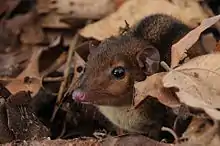List of didelphimorphs
Didelphimorphia is an order of marsupial mammals. Members of this order are called didelphimorphs, or opossums. They are primarily found in South America, though some are found in Central America and Mexico and one, the Virginia opossum, ranges into the United States and Canada. They have a variety of sizes, shapes, and fur patterns, and range in size from the 6 cm (2 in) (plus 9 cm (4 in) tail) Kalinowski's mouse opossum to the 55 cm (22 in) (plus 54 cm (21 in) tail) Virginia opossum. Didelphimorphs are primarily found in forests, as well as savannas, shrublands, and grasslands. Almost no population estimates have been made for didelphimorph species, though the one-striped opossum is classified as Critically Endangered with a population of less than ten, Handley's slender opossum is also critically endangered, and the red-bellied gracile opossum is extinct, having last been seen in 1962.

The 93 extant species of Didelphimorphia are grouped into a single family, Didelphidae, which is divided into four subfamilies: Caluromyinae, containing four species in two genera; Glironiinae, containing a single species; Hyladelphinae, also with a single species; and Didelphinae, containing 87 species split between 14 genera. Over one hundred extinct Didelphimorph species have been discovered, though due to ongoing research and discoveries the exact number and categorization is not fixed.[1]
Conventions
| Conservation status | |
|---|---|
| EX | Extinct (1 species) |
| EW | Extinct in the wild (0 species) |
| CR | Critically Endangered (2 species) |
| EN | Endangered (0 species) |
| VU | Vulnerable (6 species) |
| NT | Near threatened (3 species) |
| LC | Least concern (67 species) |
| Other categories | |
| DD | Data deficient (14 species) |
| NE | Not evaluated (0 species) |
Conservation status codes listed follow the International Union for Conservation of Nature (IUCN) Red List of Threatened Species. Range maps are provided wherever possible; if a range map is not available, a description of the didelphimorph's range is provided. Ranges are based on the IUCN Red List for that species unless otherwise noted. All extinct species or subspecies listed alongside extant species went extinct after 1500 CE, and are indicated by a dagger symbol "†".
Classification
The order Didelphimorphia consists of one family, Didelphidae, which is divided into the subfamilies Caluromyinae, Glironiinae, Hyladelphinae, and Didelphinae. Caluromyinae contains 4 species in 2 genera, Glironiinae and Hyladelphinae each contain a single species, and Didelphinae contains 87 species in 14 genera, as well as the extinct red-bellied gracile opossum, which was last seen in 1962. Many of these species are further subdivided into subspecies. This does not include hybrid species or extinct prehistoric species.[2][3]
Family Didelphidae
- Subfamily Caluromyinae
- Genus Caluromys (woolly opossums): three species
- Genus Caluromysiops (black-shouldered opossum): one species
- Subfamily Didelphinae
- Genus Chacodelphys (Chacoan pygmy opossum): one species
- Genus Chironectes (water opossum): one species
- Genus Cryptonanus (savanna gracile opossums): five species (one extinct)
- Genus Didelphis (large American opossums): six species
- Genus Gracilinanus (gracile opossums): six species
- Genus Lestodelphys (Patagonian opossum): one species
- Genus Lutreolina (lutrine opossums): two species
- Genus Marmosa (mouse opossums): seventeen species
- Genus Marmosops (slender opossums): seventeen species
- Genus Metachirus: (brown four-eyed opossums): two species
- Genus Monodelphis (short-tailed opossums): seventeen species
- Genus Philander (gray and black four-eyed opossums): five species
- Genus Thylamys (fat-tailed mouse opossums): nine species
- Genus Tlacuatzin (gray mouse opossums): one species
- Subfamily Glironiinae
- Genus Glironia (bushy-tailed opossum): one species
- Subfamily Hyladelphinae
- Genus Hyladelphys (Kalinowski's mouse opossum): one species
Didelphimorphs
The following classification is based on the taxonomy described by Mammal Species of the World (2005), with augmentation by generally accepted proposals made since using molecular phylogenetic analysis, as supported by both the IUCN and the American Society of Mammalogists.[4][5]
Subfamily Caluromyinae
| Common name | Scientific name and subspecies | Range | Size and ecology | IUCN status and estimated population |
|---|---|---|---|---|
| Bare-tailed woolly opossum
|
C. philander (Linnaeus, 1758) Four subspecies
|
Eastern and northeastern South America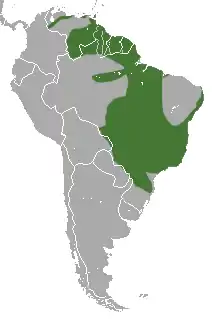 |
Size: 16–28 cm (6–11 in) long, plus 25–41 cm (10–16 in) tail[6] Habitat: Forest[7] Diet: Fruit, as well as gum, nectar, small vertebrates, and invertebrates[7] |
LC
|
| Brown-eared woolly opossum
|
C. lanatus (Olfers, 1818) Four subspecies
|
Central and northwestern South America |
Size: 20–32 cm (8–13 in) long, plus 33–44 cm (13–17 in) tail[8] Habitat: Forest[9] Diet: Fruit, invertebrates, and some small vertebrates, as well as nectar and flowers[9] |
LC
|
| Derby's woolly opossum
|
C. derbianus (Waterhouse, 1841) Six subspecies
|
Central American and northwestern South America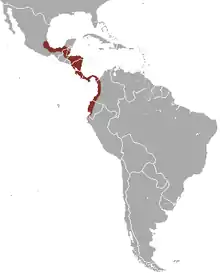 |
Size: 22–30 cm (9–12 in) long, plus 38–45 cm (15–18 in) tail[10] Habitat: Forest[11] Diet: Fruit, seeds, leaves, soft vegetables, insects, and other small invertebrates[11] |
LC
|
| Common name | Scientific name and subspecies | Range | Size and ecology | IUCN status and estimated population |
|---|---|---|---|---|
| Black-shouldered opossum | C. irrupta Sanborn, 1951 |
West-central South America |
Size: 25–33 cm (10–13 in) long, plus 31–34 cm (12–13 in) tail[12] Habitat: Forest[13] Diet: Flowers and fruit, as well as small rodents[13] |
LC
|
Subfamily Didelphinae
| Common name | Scientific name and subspecies | Range | Size and ecology | IUCN status and estimated population |
|---|---|---|---|---|
| Chacoan pygmy opossum | C. formosa (Shamel, 1930) |
Northeastern Argentina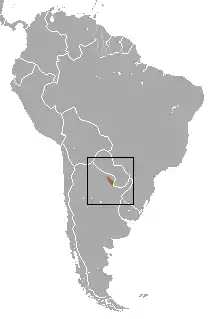 |
Size: About 7 cm (3 in) long, plus 6 cm (2 in) tail[14] Habitat: Shrubland[15] Diet: Unknown[14] |
NT
|
| Common name | Scientific name and subspecies | Range | Size and ecology | IUCN status and estimated population |
|---|---|---|---|---|
| Water opossum
|
C. minimus (Zimmermann, 1780) Four subspecies
|
Central America, northern South America, southeastern South America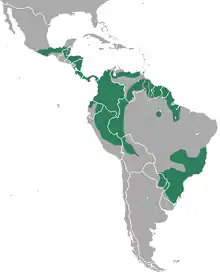 |
Size: 27–40 cm (11–16 in) long, plus 30–43 cm (12–17 in) tail[16] Habitat: Forest and inland wetlands[17] Diet: Fish, crabs, other crustaceans, and insects, as well as frogs[17] |
LC
|
| Common name | Scientific name and subspecies | Range | Size and ecology | IUCN status and estimated population |
|---|---|---|---|---|
| Agricola's gracile opossum
|
C. agricolai (Moojen, 1943) |
Eastern Brazil |
Size: 8–9 cm (3–4 in) long, plus 10–11 cm (4 in) tail[18] Habitat: Forest and shrubland[19] Diet: Unknown |
DD
|
| Chacoan gracile opossum | C. chacoensis (Tate, 1931) |
Southern South America |
Size: 8–10 cm (3–4 in) long, plus 9–13 cm (4–5 in) tail[18] Habitat: Forest and grassland[20] Diet: Unknown fruit and insects[21] |
LC
|
| Guahiba gracile opossum | C. guahybae (Tate, 1931) |
Southern Brazil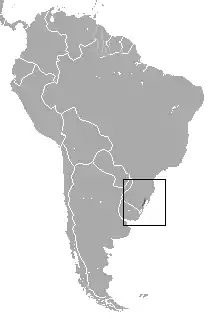 |
Size: About 9 cm (4 in) long, plus 11 cm (4 in) tail[18] Habitat: Forest and grassland[22] Diet: Unknown |
DD
|
| Red-bellied gracile opossum† | C. ignitus Díaz, Flores, Barquez, 2002 |
Northwestern Argentina | Size: About 11 cm (4 in) long, plus 12 cm (5 in) tail[18] Habitat: Forest[23] Diet: Unknown |
EX
|
| Unduavi gracile opossum | C. unduaviensis (Shamel, 1930) |
Northern Bolivia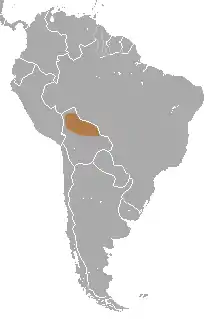 |
Size: 9–13 cm (4–5 in) long, plus 11–14 cm (4–6 in) tail[18] Habitat: Forest, grassland, and inland wetlands[24] Diet: Unknown |
DD
|
| Common name | Scientific name and subspecies | Range | Size and ecology | IUCN status and estimated population |
|---|---|---|---|---|
| Andean white-eared opossum
|
D. pernigra J. A. Allen, 1900 |
Northwestern South America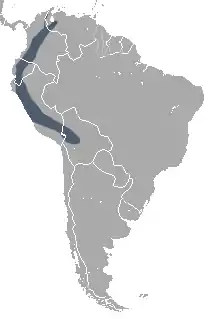 |
Size: 30–50 cm (12–20 in) long, plus 25–54 cm (10–21 in) tail[25] Habitat: Forest, shrubland, and grassland[26] Diet: Small vertebrates, carrion, invertebrates, and plants[25] |
LC
|
| Big-eared opossum
|
D. aurita (Wied-Neuwied, 1826) |
Eastern South America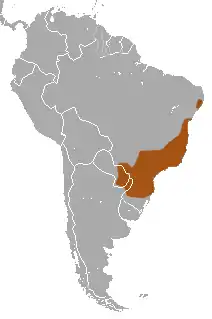 |
Size: 30–50 cm (12–20 in) long, plus 25–54 cm (10–21 in) tail[25] Habitat: Forest and shrubland[27] Diet: Arthropods and fruit, as well as other invertebrates and small vertebrates[28] |
LC
|
| Common opossum
|
D. marsupialis Linnaeus, 1758 Two subspecies
|
Central American and northern South America |
Size: 26–43 cm (10–17 in) long, plus 40 cm (16 in) tail[29] Habitat: Forest and shrubland[30] Diet: Omnivorous; eats invertebrates, vertebrates, leaves, fruit, nectar, and carrion[29] |
LC
|
| Guianan white-eared opossum | D. imperfecta Mondolfi, Hernández, 1984 |
Northern South America |
Size: 30–50 cm (12–20 in) long, plus 25–54 cm (10–21 in) tail[25] Habitat: Forest[31] Diet: Omnivorous; primarily fruit and insects[31] |
LC
|
| Virginia opossum
|
D. virginiana Kerr, 1792 Four subspecies
|
North America and Central America |
Size: 33–55 cm (13–22 in) long, plus 25–54 cm (10–21 in) tail[32] Habitat: Forest and shrubland[33] Diet: Omnivorous, including vertebrates, invertebrates, plant material, fruits, grains and carrion[32] |
LC
|
| White-eared opossum
|
D. albiventris Lund, 1840 |
Eastern and southern South America |
Size: 30–50 cm (12–20 in) long, plus 25–54 cm (10–21 in) tail[25] Habitat: Forest, savanna, and shrubland[34] Diet: Small vertebrates, carrion, invertebrates, and plants[25] |
LC
|
| Common name | Scientific name and subspecies | Range | Size and ecology | IUCN status and estimated population |
|---|---|---|---|---|
| Aceramarca gracile opossum | G. aceramarcae (Tate, 1931) |
Western Aouth America |
Size: About 11 cm (4 in) long, plus 14 cm (6 in) tail[35] Habitat: Forest[36] Diet: Fruit, insects and other small invertebrates[36] |
LC
|
| Agile gracile opossum
|
G. agilis (Burmeister, 1854) |
Central South America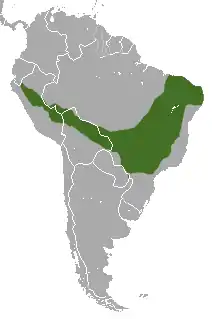 |
Size: 8–12 cm (3–5 in) long, plus 10–16 cm (4–6 in) tail[37] Habitat: Forest[38] Diet: Insects and fruit[39] |
LC
|
| Brazilian gracile opossum
|
G. microtarsus (Wagner, 1842) Two subspecies
|
Southeastern South America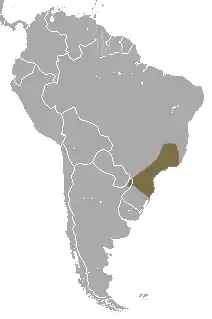 |
Size: About 10 cm (4 in) long, plus 13 cm (5 in) tail[40] Habitat: Forest[41] Diet: Insects, other invertebrates, and fruit[40] |
LC
|
| Emilia's gracile opossum | G. emiliae (Thomas, 1909) |
Scattered northern South America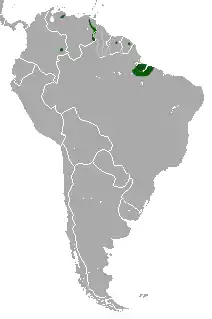 |
Size: About 8 cm (3 in) long, plus 14 cm (6 in) tail[42] Habitat: Forest[43] Diet: Believed to be insects and fruit[42] |
DD
|
| Northern gracile opossum | G. marica (Thomas, 1898) |
Northern South America |
Size: About 10 cm (4 in) long, plus 13 cm (5 in) tail[44] Habitat: Forest and grassland[45] Diet: Believed to be insects and fruit[44] |
LC
|
| Wood sprite gracile opossum | G. dryas (Thomas, 1898) |
Northern South America |
Size: About 11 cm (4 in) long, plus 14 cm (6 in) tail[46] Habitat: Forest[47] Diet: Believed to be insects and fruit[46] |
LC
|
| Common name | Scientific name and subspecies | Range | Size and ecology | IUCN status and estimated population |
|---|---|---|---|---|
| Patagonian opossum | L. halli (Thomas, 1921) |
Southern South America |
Size: 13–15 cm (5–6 in) long, plus 8–10 cm (3–4 in) tail[48] Habitat: Shrubland, grassland, and desert[49] Diet: Invertebrates, as well as birds, reptiles, and fruit[48] |
LC
|
| Common name | Scientific name and subspecies | Range | Size and ecology | IUCN status and estimated population |
|---|---|---|---|---|
| Big lutrine opossum
|
L. crassicaudata (Desmarest, 1804) Two subspecies
|
Scattered South America (Massoia's lutrine opossum in red) |
Size: 26–35 cm (10–14 in) long, plus 24–30 cm (9–12 in) tail[50] Habitat: Forest, grassland, and inland wetlands[51] Diet: Omnivorous; crabs, beetles, amphibians, birds, seeds, and vegetation, as well as other invertebrates, fish, and small mammals[50] |
LC
|
| Massoia's lutrine opossum | L. massoia Martínez-Lanfranco, Flores, Jayat, D'Elía, 2014 |
South-central South America (big lutrine opossum in green) |
Size: 18–24 cm (7–9 in) long, plus 20–26 cm (8–10 in) tail[52] Habitat: Forest and grassland[53] Diet: Small mammals, fish, and invertebrates, as well as bird eggs and fruit[52] |
LC
|
| Common name | Scientific name and subspecies | Range | Size and ecology | IUCN status and estimated population |
|---|---|---|---|---|
| Alston's mouse opossum
|
M. alstoni (Allen, 1900) |
Central America, northwestern tip of South America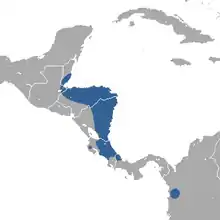 |
Size: 18–20 cm (7–8 in) long, plus 24–28 cm (9–11 in) tail[54] Habitat: Forest[55] Diet: Insects, small vertebrates, and fruit[55] |
LC
|
| Bare-tailed woolly mouse opossum | M. regina Thomas, 1924 |
Western South America | Size: 15–21 cm (6–8 in) long, plus 21–30 cm (8–12 in) tail[56] Habitat: Forest[56] Diet: Insects and fruit, as well as nectar, small vertebrates, and eggs[57] |
NE
|
| Guajira mouse opossum | M. xerophila Handley, Gordon, 1979 |
Northern South America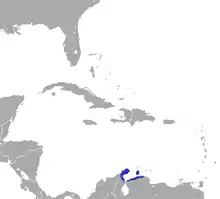 |
Size: 8–16 cm (3–6 in) long, plus 10–20 cm (4–8 in) tail[58] Habitat: Forest and shrubland[59] Diet: Insects and fruit, as well as lizards, bird eggs, and small rodents[59] |
VU
|
| Heavy-browed mouse opossum | M. andersoni Pine, 1972 |
Peru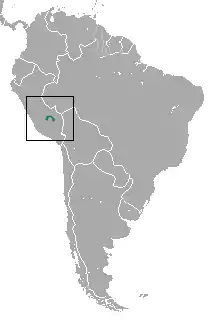 |
Size: 8–22 cm (3–9 in) long, plus 12–27 cm (5–11 in) tail[57] Habitat: Forest[60] Diet: Insects, as well as fruit[61] |
DD
|
| Linnaeus's mouse opossum
|
M. murina (Linnaeus, 1758) |
Northern and eastern South America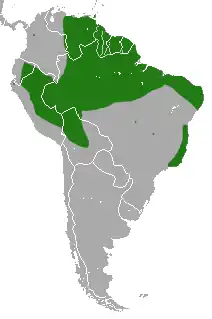 |
Size: 11–15 cm (4–6 in) long, plus 13–21 cm (5–8 in) tail[62] Habitat: Forest[63] Diet: Insects, small animals, and fruit[63] |
LC
|
| Little woolly mouse opossum | M. phaea Thomas, 1899 |
Northwestern South America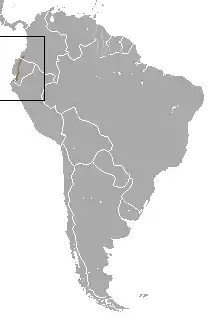 |
Size: 8–22 cm (3–9 in) long, plus 12–27 cm (5–11 in) tail[57] Habitat: Forest[64] Diet: Insects and fruit, as well as nectar, small vertebrates, and eggs[57] |
VU
|
| Mexican mouse opossum
|
M. mexicana Merriam, 1897 Three subspecies
|
Mexico and Central America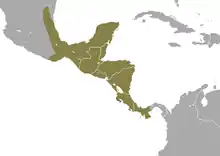 |
Size: 9–17 cm (4–7 in) long, plus 13–23 cm (5–9 in) tail[58] Habitat: Forest and grassland[65] Diet: Insects and fruit, as well as small rodents, lizards, birds, and eggs[65] |
LC
|
| Quechuan mouse opossum | M. quichua Wagner, 1842 |
Western South America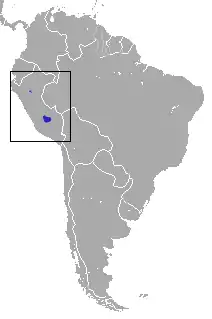 |
Size: 8–22 cm (3–9 in) long, plus 12–27 cm (5–11 in) tail[57] Habitat: Forest[66] Diet: Insects and fruit, as well as nectar, small vertebrates, and eggs[57] |
LC
|
| Red mouse opossum | M. rubra Tate, 1931 |
Western South America |
Size: 12–20 cm (5–8 in) long, plus 18–22 cm (7–9 in) tail[58] Habitat: Forest[67] Diet: Insects and fruit[68] |
DD
|
| Robinson's mouse opossum
|
M. robinsoni Bangs, 1898 Six subspecies
|
Northern South America and Central America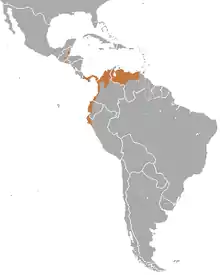 |
Size: 8–22 cm (3–9 in) long, plus 10–22 cm (4–9 in) tail[58] Habitat: Forest and savanna[69] Diet: Fruit and insects[69] |
LC
|
| Rufous mouse opossum
|
M. lepida (Thomas, 1888) |
Northwestern South America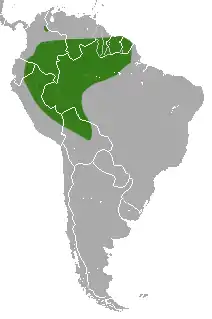 |
Size: 8–22 cm (3–9 in) long, plus 12–27 cm (5–11 in) tail[57] Habitat: Forest[70] Diet: Insects and fruit[70] |
LC
|
| Tate's woolly mouse opossum
|
M. paraguayana Tate, 1931 Two subspecies
|
Southeastern South America | Size: 8–22 cm (3–9 in) long, plus 12–27 cm (5–11 in) tail[57] Habitat: Forest[71] Diet: Omnivorous and insectivorous[71] |
LC
|
| Tyler's mouse opossum | M. tyleriana Tate, 1931 |
Northern South America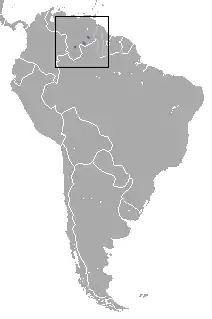 |
Size: 8–22 cm (3–9 in) long, plus 12–27 cm (5–11 in) tail[57] Habitat: Forest[72] Diet: Insects as well as fruit[73] |
DD
|
| White-bellied woolly mouse opossum | M. constantiae Thomas, 1904 |
Central South America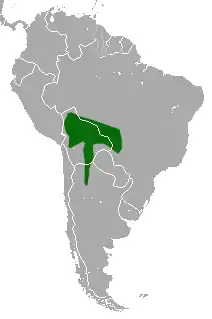 |
Size: 8–22 cm (3–9 in) long, plus 12–27 cm (5–11 in) tail[57] Habitat: Forest[74] Diet: Insects and fruit, as well as nectar, small vertebrates, and eggs[57] |
LC
|
| Woolly mouse opossum | M. demerarae Thomas, 1905 Four subspecies
|
Northeastern South America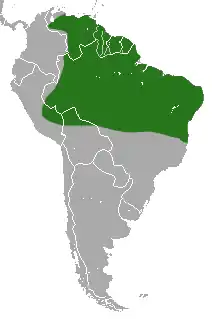 |
Size: 8–22 cm (3–9 in) long, plus 12–27 cm (5–11 in) tail[57] Habitat: Forest[75] Diet: Insects, small animals, fruit, and nectar[75] |
LC
|
| Common name | Scientific name and subspecies | Range | Size and ecology | IUCN status and estimated population |
|---|---|---|---|---|
| Andean Slender Mouse Opossum | M. caucae (Thomas, 1900) |
Northwestern South America | Size: 9–17 cm (4–7 in) long, plus 10–22 cm (4–9 in) tail[76] Habitat: Forest[77] Diet: Insects and fruit[76] |
LC
|
| Bishop's slender opossum | M. bishopi (Pine, 1981) |
Central South America |
Size: 9–12 cm (4–5 in) long, plus 11–16 cm (4–6 in) tail[78] Habitat: Forest[79] Diet: Insects and fruit[76] |
LC
|
| Brazilian slender opossum | M. paulensis (Tate, 1931) |
Southeastern Brazil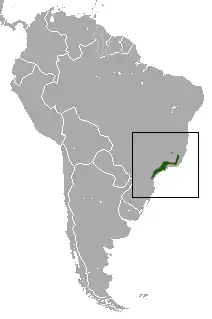 |
Size: 9–17 cm (4–7 in) long, plus 10–22 cm (4–9 in) tail[76] Habitat: Forest[80] Diet: Insects and fruit[76] |
LC
|
| Creighton's slender opossum | M. creightoni Voss, Tarifa, Yensen, 2004 |
Zongo River valley in Bolivia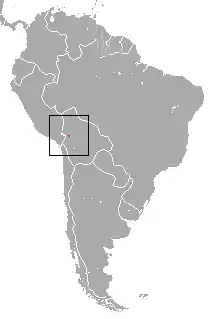 |
Size: 9–17 cm (4–7 in) long, plus 10–22 cm (4–9 in) tail[76] Habitat: Forest[81] Diet: Insects and fruit[76] |
DD
|
| Delicate slender opossum | M. parvidens (Tate, 1931) |
Northern South America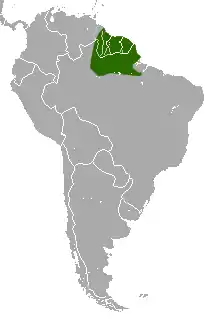 |
Size: 9–11 cm (4 in) long, plus 14–16 cm (6–6 in) tail[78] Habitat: Forest[82] Diet: Insects and fruit[76] |
LC
|
| Dusky slender opossum | M. fuscatus (Thomas, 1896) Two subspecies
|
Northern South America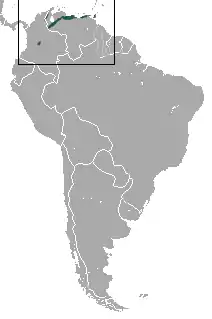 |
Size: 13–14 cm (5–6 in) long, plus 14–15 cm (6–6 in) tail[78] Habitat: Forest[83] Diet: Insects and fruit[76] |
DD
|
| Gray slender opossum
|
M. incanus (Lund, 1841) |
Eastern South America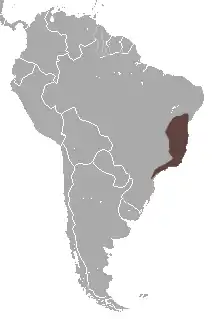 |
Size: 9–17 cm (4–7 in) long, plus 10–22 cm (4–9 in) tail[76] Habitat: Forest[84] Diet: Insects and fruit[76] |
LC
|
| Handley's slender opossum | M. handleyi (Pine, 1981) |
Central Columbia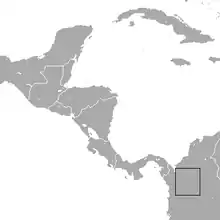 |
Size: 10–13 cm (4–5 in) long, plus 12–15 cm (5–6 in) tail[78] Habitat: Forest[85] Diet: Insects and fruit[76] |
CR
|
| Junin slender opossum | M. juninensis (Tate, 1931) |
Central Peru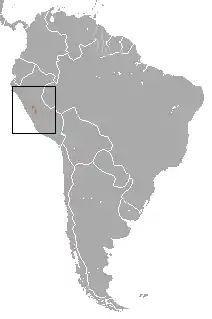 |
Size: 9–11 cm (4 in) long, plus 12–14 cm (5–6 in) tail[78] Habitat: Forest[86] Diet: Insects and fruit[76] |
VU
|
| Narrow-headed slender opossum | M. cracens Handley, Gordon, 1979 |
Northern South America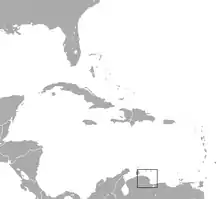 |
Size: 9–17 cm (4–7 in) long, plus 10–22 cm (4–9 in) tail[76] Habitat: Forest[87] Diet: Insects and fruit[76] |
DD
|
| Neblina slender opossum | M. neblina Gardner, 1990 |
Northwestern South America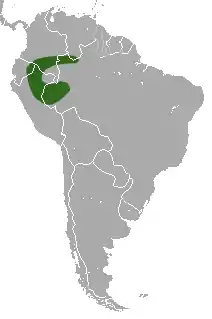 |
Size: 9–17 cm (4–7 in) long, plus 10–22 cm (4–9 in) tail[76] Habitat: Forest[88] Diet: Insects and fruit[76] |
LC
|
| Panama slender opossum | M. invictus (Goldman, 1921) |
Panama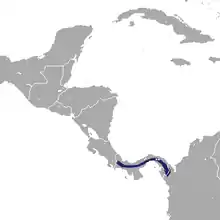 |
Size: 10–12 cm (4–5 in) long, plus 12–15 cm (5–6 in) tail[78] Habitat: Forest[89] Diet: Insects and fruit[76] |
LC
|
| Pantepui slender opossum | M. pakaraimae Voss, Lim, Díaz-Nieto, Jansa, 2013 |
Northern South America | Size: 10–12 cm (4–5 in) long, plus 15–17 cm (6–7 in) tail[78] Habitat: Forest[90] Diet: Insects and fruit[76] |
VU
|
| Pinheiro's slender opossum | M. pinheiroi (Pine, 1981) |
Northern South America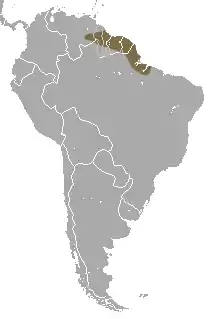 |
Size: 8–13 cm (3–5 in) long, plus 12–16 cm (5–6 in) tail[78] Habitat: Forest[91] Diet: Insects and fruit[76] |
LC
|
| Spectacled slender opossum | M. ocellatus (Tate, 1931) |
Bolivia | Size: 9–17 cm (4–7 in) long, plus 10–22 cm (4–9 in) tail[76] Habitat: Forest[92] Diet: Insects and fruit[76] |
LC
|
| Tschudi's slender opossum | M. impavidus Tschudi, 1844 |
Northwestern South America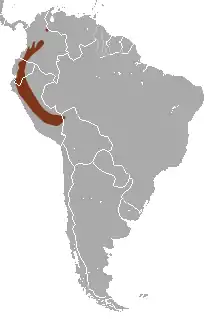 |
Size: 9–17 cm (4–7 in) long, plus 10–22 cm (4–9 in) tail[76] Habitat: Forest[93] Diet: Insects and fruit[76] |
LC
|
| White-bellied slender opossum
|
M. noctivagus (Tschudi, 1844) |
Western South America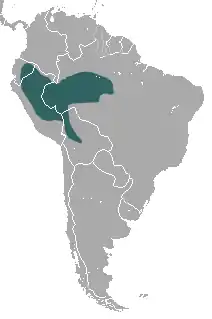 |
Size: 9–17 cm (4–7 in) long, plus 10–22 cm (4–9 in) tail[76] Habitat: Forest[94] Diet: Insects and fruit[76] |
LC
|
| Common name | Scientific name and subspecies | Range | Size and ecology | IUCN status and estimated population |
|---|---|---|---|---|
| Brown four-eyed opossum
|
M. nudicaudatus (Geoffroy, 1803) Four subspecies
|
South America and Central America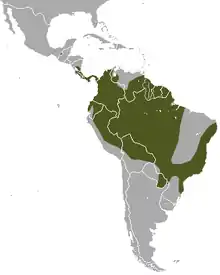 |
Size: 19–31 cm (7–12 in) long, plus 19–39 cm (7–15 in) tail[95] Habitat: Forest and shrubland[96] Diet: Insects and other invertebrates, as well as fruit, seeds, and small mammals[95] |
LC
|
| Common name | Scientific name and subspecies | Range | Size and ecology | IUCN status and estimated population |
|---|---|---|---|---|
| Amazonian red-sided opossum | M. glirina (Wagner, 1842) |
Central South America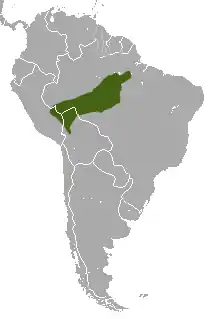 |
Size: 7–20 cm (3–8 in) long, plus 4–11 cm (2–4 in) tail[97] Habitat: Forest[98] Diet: Small vertebrates, insects, carrion, seeds, and fruit[97] |
LC
|
| Emilia's short-tailed opossum | M. emiliae (Thomas, 1912) |
Central South America |
Size: 7–20 cm (3–8 in) long, plus 4–11 cm (2–4 in) tail[97] Habitat: Forest[99] Diet: Small vertebrates, insects, carrion, seeds, and fruit[97] |
LC
|
| Gray short-tailed opossum
|
M. domestica (Wagner, 1842) |
Central and eastern South America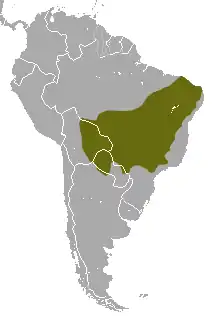 |
Size: 10–15 cm (4–6 in) long, plus tail[100] Habitat: Forest, shrubland, and grassland[101] Diet: Insects, fruits, and small animals[100] |
LC
|
| Handley's short-tailed opossum | M. handleyi Solari, 2007 |
Central South America | Size: 7–20 cm (3–8 in) long, plus 4–11 cm (2–4 in) tail[97] Habitat: Forest[102] Diet: Small vertebrates, insects, carrion, seeds, and fruit[97] |
DD
|
| Hooded red-sided opossum | M. palliolata (Osgood, 1914) |
Northern South America |
Size: 7–20 cm (3–8 in) long, plus 4–11 cm (2–4 in) tail[97] Habitat: Forest[103] Diet: Small vertebrates, insects, carrion, seeds, and fruit[97] |
LC
|
| Ihering's three-striped opossum | M. iheringi (Thomas, 1888) |
Eastern South America |
Size: 7–20 cm (3–8 in) long, plus 4–11 cm (2–4 in) tail[97] Habitat: Forest and unknown[104] Diet: Small vertebrates, insects, carrion, seeds, and fruit[97] |
DD
|
| Long-nosed short-tailed opossum
|
M. scalops (Thomas, 1888) |
Eastern South America |
Size: 7–20 cm (3–8 in) long, plus 4–11 cm (2–4 in) tail[97] Habitat: Forest[105] Diet: Small vertebrates, insects, carrion, seeds, and fruit[97] |
LC
|
| Northern red-sided opossum
|
M. brevicaudata (Erxleben, 1777) |
Northern South America |
Size: 7–20 cm (3–8 in) long, plus 4–11 cm (2–4 in) tail[97] Habitat: Forest[106] Diet: Small vertebrates, insects, carrion, seeds, and fruit[97] |
LC
|
| Northern three-striped opossum
|
M. americana (Müller, 1776) |
Eastern South America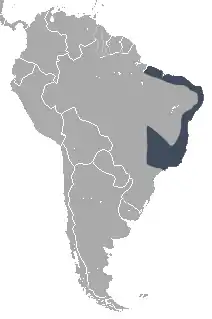 |
Size: 7–20 cm (3–8 in) long, plus 4–11 cm (2–4 in) tail[97] Habitat: Forest and shrubland[107] Diet: Small vertebrates, insects, carrion, seeds, and fruit[97] |
LC
|
| One-striped opossum | M. unistriata (Wagner, 1842) |
Southeastern South America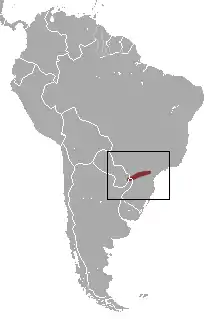 |
Size: 7–20 cm (3–8 in) long, plus 4–11 cm (2–4 in) tail[97] Habitat: Forest[108] Diet: Small vertebrates, insects, carrion, seeds, and fruit[97] |
CR
|
| Osgood's short-tailed opossum | M. osgoodi Doutt, 1938 |
Western South America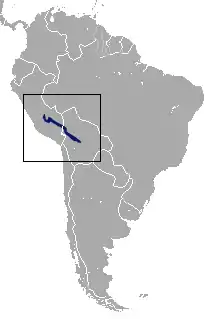 |
Size: 7–20 cm (3–8 in) long, plus 4–11 cm (2–4 in) tail[97] Habitat: Forest[109] Diet: Small vertebrates, insects, carrion, seeds, and fruit[97] |
LC
|
| Peruvian short-tailed opossum | M. peruviana (Osgood, 1913) |
Peru | Size: 7–20 cm (3–8 in) long, plus 4–11 cm (2–4 in) tail[97] Habitat: Forest[110] Diet: Small vertebrates, insects, carrion, seeds, and fruit[97] |
LC
|
| Pygmy short-tailed opossum | M. kunsi Pine, 1975 |
Central South America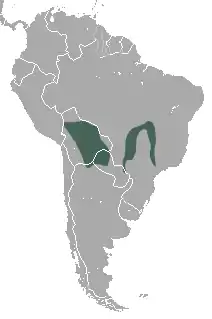 |
Size: 7–20 cm (3–8 in) long, plus 4–11 cm (2–4 in) tail[97] Habitat: Forest and savanna[111] Diet: Small vertebrates, insects, carrion, seeds, and fruit[97] |
LC
|
| Reig's opossum | M. reigi Lew, Pérez-Hernández, 2004 |
Northern South America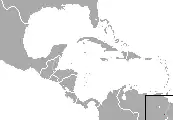 |
Size: 7–20 cm (3–8 in) long, plus 4–11 cm (2–4 in) tail[97] Habitat: Forest[112] Diet: Small vertebrates, insects, carrion, seeds, and fruit[97] |
VU
|
| Ronald's opossum | M. ronaldi Solari, 2004 |
Western South America |
Size: 7–20 cm (3–8 in) long, plus 4–11 cm (2–4 in) tail[97] Habitat: Forest[113] Diet: Small vertebrates, insects, carrion, seeds, and fruit[97] |
LC
|
| Sepia short-tailed opossum | M. adusta (Thomas, 1897) |
Northwestern South America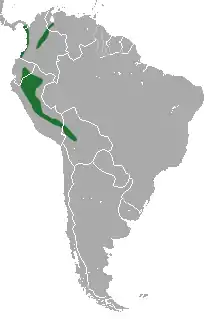 |
Size: 9–13 cm (4–5 in) long, plus 4–7 cm (2–3 in) tail[114] Habitat: Forest[115] Diet: Invertebrates, fruits and small vertebrates[114] |
LC
|
| Yellow-sided opossum
|
M. dimidiata (Wagner, 1847) |
Southern South America |
Size: 7–20 cm (3–8 in) long, plus 4–11 cm (2–4 in) tail[97] Habitat: Forest, grassland, and inland wetlands[116] Diet: Small vertebrates, insects, carrion, seeds, and fruit[97] |
LC
|
| Common name | Scientific name and subspecies | Range | Size and ecology | IUCN status and estimated population |
|---|---|---|---|---|
| Anderson's four-eyed opossum
|
P. andersoni (Osgood, 1913) |
Northwestern South America |
Size: 25–35 cm (10–14 in) long, plus 25–35 cm (10–14 in) tail[117] Habitat: Forest[118] Diet: Insects, other small invertebrates, eggs, and fruit[117] |
LC
|
| Deltaic four-eyed opossum | P. deltae Lew, Pérez-Hernández, Ventura, 2006 |
Northern South America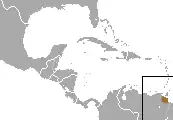 |
Size: 20–38 cm (8–15 in) long, plus 19–36 cm (7–14 in) tail[119] Habitat: Forest and inland wetlands[120] Diet: Small mammals, other small vertebrates, eggs, insects, other invertebrates, fruit, and carrion[119] |
LC
|
| Gray four-eyed opossum
|
P. opossum (Linnaeus, 1758) Two subspecies
|
Northern and central South America and Central America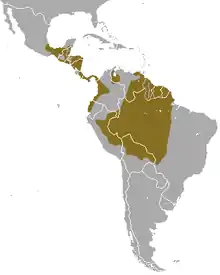 |
Size: 20–34 cm (8–13 in) long, plus 19–36 cm (7–14 in) tail[121] Habitat: Forest and shrubland[122] Diet: Omnivorous, including invertebrates, small animals, leaves, bark, seeds, nuts, nectar, and fruit[121] |
LC
|
| McIlhenny's four-eyed opossum | P. mcilhennyi Gardner, Patton, 1972 |
Central South America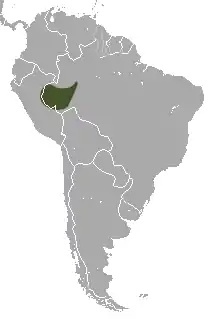 |
Size: 28–31 cm (11–12 in) long, plus 26–38 cm (10–15 in) tail[123] Habitat: Forest[124] Diet: Believed to be omnivorous[123] |
LC
|
| Southeastern four-eyed opossum | P. frenatus Olfers, 1818 |
 |
Size: 21–29 cm (8–11 in) long, plus 17–32 cm (7–13 in) tail[125] Habitat: Forest[126] Diet: Omnivorous, including flowers, fruit, invertebrates, and small vertebrates[126] |
LC
|
| Common name | Scientific name and subspecies | Range | Size and ecology | IUCN status and estimated population |
|---|---|---|---|---|
| Argentine fat-tailed mouse opossum | T. sponsorius (Thomas, 1921) |
Central South America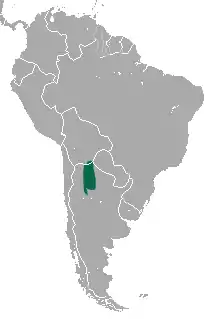 |
Size: 6–15 cm (2–6 in) long, plus 6–17 cm (2–7 in) tail[127] Habitat: Shrubland[128] Diet: Insects, as well as fruit and small vertebrates[127] |
LC
|
| Buff-bellied fat-tailed mouse opossum | T. venustus (Thomas, 1902) |
Central South America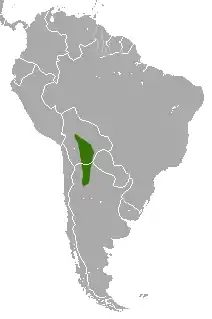 |
Size: 6–15 cm (2–6 in) long, plus 6–17 cm (2–7 in) tail[127] Habitat: Forest, savanna, and shrubland[129] Diet: Insects, as well as fruit and small vertebrates[127] |
DD
|
| Common fat-tailed mouse opossum | T. pusillus (Desmarest, 1804) |
Central South America |
Size: 7–12 cm (3–5 in) long, plus 8–14 cm (3–6 in) tail[130] Habitat: Forest and savanna[131] Diet: Insects, as well as fruit and small vertebrates[127] |
LC
|
| Dwarf fat-tailed mouse opossum | T. velutinus (Wagner, 1842) |
Eastern South America |
Size: 6–15 cm (2–6 in) long, plus 6–17 cm (2–7 in) tail[127] Habitat: Forest, savanna, shrubland, and grassland[132] Diet: Insects, as well as fruit and small vertebrates[127] |
NT
|
| Elegant fat-tailed mouse opossum
|
T. elegans (Waterhouse, 1839) |
Southwestern South America |
Size: 6–15 cm (2–6 in) long, plus 6–17 cm (2–7 in) tail[127] Habitat: Forest and shrubland[133] Diet: Insects, as well as fruit and small vertebrates[127] |
LC
|
| Karimi's fat-tailed mouse opossum | T. karimii (Petter, 1968) |
Central South America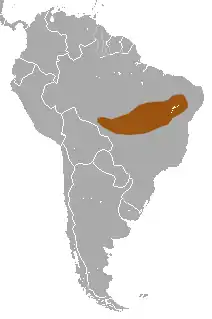 |
Size: 6–15 cm (2–6 in) long, plus 6–17 cm (2–7 in) tail[127] Habitat: Forest and savanna[134] Diet: Insects, as well as fruit and small vertebrates[127] |
VU
|
| Paraguayan fat-tailed mouse opossum | T. macrurus (Olfers, 1818) |
Central South America |
Size: 6–15 cm (2–6 in) long, plus 6–17 cm (2–7 in) tail[127] Habitat: Forest, savanna, and shrubland[135] Diet: Insects, as well as fruit and small vertebrates[127] |
NT
|
| Tate's fat-tailed mouse opossum | T. tatei (Handley, 1957) |
Western South America |
Size: 6–15 cm (2–6 in) long, plus 6–17 cm (2–7 in) tail[127] Habitat: Shrubland and desert[136] Diet: Insects, as well as fruit and small vertebrates[127] |
DD
|
| White-bellied fat-tailed mouse opossum | T. pallidior (Thomas, 1902) |
Southwestern South America |
Size: 7–11 cm (3–4 in) long, plus 9–12 cm (4–5 in) tail[137] Habitat: Shrubland and desert[138] Diet: Arthropods, as well as leaves, fruit, and seeds[137] |
LC
|
| Common name | Scientific name and subspecies | Range | Size and ecology | IUCN status and estimated population |
|---|---|---|---|---|
| Grayish mouse opossum
|
T. canescens (Allen, 1893) |
Southern Mexico | Size: 8–15 cm (3–6 in) long, plus 9–17 cm (4–7 in) tail[139] Habitat: Forest and shrubland[140] Diet: Insects and fruit[139] |
LC
|
Subfamily Glironiinae
| Common name | Scientific name and subspecies | Range | Size and ecology | IUCN status and estimated population |
|---|---|---|---|---|
| Bushy-tailed opossum | G. venusta Thomas, 1912 |
West-central South America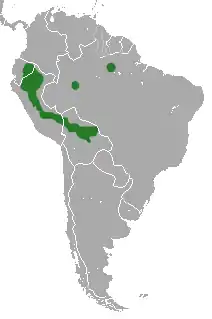 |
Size: 13–20 cm (5–8 in) long, plus 19–23 cm (7–9 in) tail[141] Habitat: Forest[142] Diet: Insects, seeds, fruit, and eggs[142] |
LC
|
Subfamily Hyladelphinae
| Common name | Scientific name and subspecies | Range | Size and ecology | IUCN status and estimated population |
|---|---|---|---|---|
| Kalinowski's mouse opossum | H. kalinowskii (Hershkovitz, 1992) |
North-central South America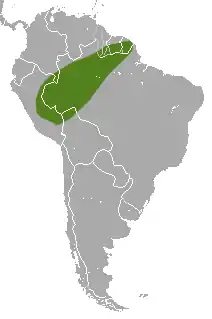 |
Size: 6–10 cm (2–4 in) long, plus 9–12 cm (4–5 in) tail[143] Habitat: Forest[144] Diet: Unknown |
LC
|
References
- "Fossilworks: Didelphimorphia". Paleobiology Database. University of Wisconsin–Madison. Retrieved February 5, 2022.
- Voss, R. S.; Jansa, S. A. (2009). "Phylogenetic relationships and classification of didelphid marsupials, an extant radiation of New World metatherian mammals". Bulletin of the American Museum of Natural History. 322: 1–177. doi:10.1206/322.1. hdl:2246/5975. S2CID 85017821.
- Upham, N. S.; Esselstyn, J. A.; Jetz, W. (2019). "Inferring the mammal tree: Species-level sets of phylogenies for questions in ecology, evolution and conservation". PLOS Biology. 17 (12): e3000494. doi:10.1371/journal.pbio.3000494. PMC 6892540. PMID 31800571.
- Wilson, Reeder, pp. 3–18
- "ASM Mammal Diversity Database – Explore the Database". American Society of Mammalogists. Retrieved November 16, 2022. (Search for 'Didelphimorphs')
- Strassman, Andrew (2004). "Caluromys philander". Animal Diversity Web. University of Michigan. Retrieved December 7, 2021.
- Brito, D.; Astúa, D.; Lew, D.; Soriano, P.; Emmons, L. (2021) [amended version of 2015 assessment]. "Caluromys philander". IUCN Red List of Threatened Species. 2021: e.T3649A197321055. doi:10.2305/IUCN.UK.2021-1.RLTS.T3649A197321055.en.
- Cable, Rachel (2013). "Caluromys lanatus". Animal Diversity Web. University of Michigan. Retrieved December 7, 2021.
- Costa, L. P.; Astúa, D.; Brito, D.; Lew, D.; Tarifa, T. (2021) [amended version of 2015 assessment]. "Caluromys lanatus". IUCN Red List of Threatened Species. 2021: e.T3648A197310136. doi:10.2305/IUCN.UK.2021-1.RLTS.T3648A197310136.en.
- Cable, Rachel; Martina, Leila Siciliano (2013). "Caluromys derbianus". Animal Diversity Web. University of Michigan. Retrieved December 7, 2021.
- Solari, S.; Lew, D. (2015). "Caluromys derbianus". IUCN Red List of Threatened Species. 2015: e.T3650A22175821. doi:10.2305/IUCN.UK.2015-4.RLTS.T3650A22175821.en.
- Martina, Leila Siciliano (2014). "Caluromysiops irrupta". Animal Diversity Web. University of Michigan. Retrieved December 7, 2021.
- Solari, S.; Cáceres, N. (2016) [errata version of 2015 assessment]. "Caluromysiops irrupta". IUCN Red List of Threatened Species. 2015: e.T3651A97206475. doi:10.2305/IUCN.UK.2015-4.RLTS.T3651A22172207.en.
- Nowak, p. 80
- Teta, P.; de la Sancha, N.; Flores, D. (2016). "Chacodelphys formosa". IUCN Red List of Threatened Species. 2016: e.T136547A22175485. doi:10.2305/IUCN.UK.2016-3.RLTS.T136547A22175485.en.
- McHugh, Taylor; Small, Christine (2013). "Chironectes minimus". Animal Diversity Web. University of Michigan. Retrieved December 7, 2021.
- Pérez-Hernandez, R.; Brito, D.; Tarifa, T.; Cáceres, N.; Lew, D.; Solari, S. (2016). "Chironectes minimus". IUCN Red List of Threatened Species. 2016: e.T4671A22173467. doi:10.2305/IUCN.UK.2016-1.RLTS.T4671A22173467.en.
- Voss, R. S.; Lunde, D. P.; Jansa, S. A. (2005). "On the Contents of Gracilinanus Gardner and Creighton, 1989, with the Description of a Previously Unrecognized Clade of Small Didelphid Marsupials". American Museum Novitates (3482): 1–36. doi:10.1206/0003-0082(2005)482[0001:OTCOGG]2.0.CO;2. S2CID 84269504.
- Carmignotto, A. P.; Astúa, D.; Cáceres, N. (2021) [amended version of 2016 assessment]. "Cryptonanus agricolai". IUCN Red List of Threatened Species. 2021: e.T136545A197311847. doi:10.2305/IUCN.UK.2021-1.RLTS.T136545A197311847.en.
- Teta, P.; Martin, G. M. (2016). "Cryptonanus chacoensis". IUCN Red List of Threatened Species. 2016: e.T136845A22177997. doi:10.2305/IUCN.UK.2016-1.RLTS.T136845A22177997.en.
- Martina, Leila Siciliano (2014). "Cryptonanus chacoensis". Animal Diversity Web. University of Michigan. Retrieved December 19, 2021.
- Carmignotto, A. P.; Costa, L. P.; Brito, D.; Astúa, D. (2021) [amended version of 2016 assessment]. "Cryptonanus guahybae". IUCN Red List of Threatened Species. 2021: e.T136705A197313066. doi:10.2305/IUCN.UK.2021-1.RLTS.T136705A197313066.en.
- Flores, D. (2016). "Cryptonanus ignitus". IUCN Red List of Threatened Species. 2016: e.T41320A22177809. doi:10.2305/IUCN.UK.2016-2.RLTS.T41320A22177809.en.
- Carmignotto, A. P. (2021) [amended version of 2016 assessment]. "Cryptonanus unduaviensis". IUCN Red List of Threatened Species. 2021: e.T136749A197312011. doi:10.2305/IUCN.UK.2021-1.RLTS.T136749A197312011.en.
- Nowak, pp. 73–74
- Pérez-Hernandez, R.; Solari, S.; Tarifa, T.; Lew, D. (2016). "Didelphis pernigra". IUCN Red List of Threatened Species. 2016: e.T136395A22176668. doi:10.2305/IUCN.UK.2016-1.RLTS.T136395A22176668.en.
- Astúa, D.; de la Sancha, N.; Costa, L. (2021) [amended version of 2015 assessment]. "Didelphis aurita". IUCN Red List of Threatened Species. 2021: e.T40500A197310366. doi:10.2305/IUCN.UK.2021-1.RLTS.T40500A197310366.en.
- Cusick, Patrick (2013). "Didelphis aurita". Animal Diversity Web. University of Michigan. Retrieved December 21, 2021.
- Martina, Leila Siciliano (2014). "Didelphis marsupialis". Animal Diversity Web. University of Michigan. Retrieved December 7, 2021.
- Astúa, D.; Lew, D.; Costa, L. P.; Pérez-Hernandez, R. (2021) [amended version of 2016 assessment]. "Didelphis marsupialis". IUCN Red List of Threatened Species. 2021: e.T40501A197310576. doi:10.2305/IUCN.UK.2021-1.RLTS.T40501A197310576.en.
- Pérez-Hernandez, R.; López Fuster, M.; Ventura, J.; Lew, D. (2016). "Didelphis imperfecta". IUCN Red List of Threatened Species. 2016: e.T136592A22176554. doi:10.2305/IUCN.UK.2016-1.RLTS.T136592A22176554.en.
- Martina, Leila Siciliano (2013). "Didelphis virginiana". Animal Diversity Web. University of Michigan. Retrieved December 7, 2021.
- Pérez-Hernandez, R.; Lew, D.; Solari, S. (2016). "Didelphis virginiana". IUCN Red List of Threatened Species. 2016: e.T40502A22176259. doi:10.2305/IUCN.UK.2016-1.RLTS.T40502A22176259.en.
- Costa, L. P.; Astúa, D.; Brito, D.; Soriano, P.; Lew, D. (2021) [amended version of 2015 assessment]. "Didelphis albiventris". IUCN Red List of Threatened Species. 2021: e.T40489A197310863. doi:10.2305/IUCN.UK.2021-1.RLTS.T40489A197310863.en.
- Martina, Leila Siciliano (2013). "Gracilinanus aceramarcae". Animal Diversity Web. University of Michigan. Retrieved December 23, 2021.
- Solari, S.; Tarifa, T. (2016). "Gracilinanus aceramarcae". IUCN Red List of Threatened Species. 2016: e.T9416A22169509. doi:10.2305/IUCN.UK.2016-1.RLTS.T9416A22169509.en.
- Semedo, T.; Brandão, M. V.; Rossi, R. (2015). "Taxonomic status and phylogenetic relationships of Marmosa agilis peruana Tate, 1931 (Didelphimorphia: Didelphidae), with comments on the morphological variation of Gracilinanus from central-western Brazil". Zoological Journal of the Linnean Society (173): 190–216. doi:10.1111/zoj.12203. S2CID 83144697.
- Carmignotto, A. P.; Solari, S.; de la Sancha, N.; Costa, L. (2015). "Gracilinanus agilis". IUCN Red List of Threatened Species. 2015: e.T9417A22169828. doi:10.2305/IUCN.UK.2015-4.RLTS.T9417A22169828.en.
- Martina, Leila Siciliano (2013). "Gracilinanus agilis". Animal Diversity Web. University of Michigan. Retrieved December 23, 2021.
- Martina, Leila Siciliano (2013). "Gracilinanus microtarsus". Animal Diversity Web. University of Michigan. Retrieved December 7, 2021.
- Brito, D.; Astúa, D.; Lew, D.; Soriano, P. (2021) [amended version of 2015 assessment]. "Gracilinanus microtarsus". IUCN Red List of Threatened Species. 2021: e.T9421A197306376. doi:10.2305/IUCN.UK.2021-1.RLTS.T9421A197306376.en.
- Martina, Leila Siciliano (2013). "Gracilinanus emiliae". Animal Diversity Web. University of Michigan. Retrieved December 23, 2021.
- Pérez-Hernandez, R.; Brito, D.; Astúa, D.; Carmignotto, A. P. (2021) [amended version of 2016 assessment]. "Gracilinanus emiliae". IUCN Red List of Threatened Species. 2021: e.T9419A197307208. doi:10.2305/IUCN.UK.2021-1.RLTS.T9419A197307208.en.
- Martina, Leila Siciliano (2013). "Gracilinanus marica". Animal Diversity Web. University of Michigan. Retrieved December 23, 2021.
- Pérez-Hernandez, R.; Ventura, J.; López Fuster, M. (2016). "Gracilinanus marica". IUCN Red List of Threatened Species. 2016: e.T9420A22169944. doi:10.2305/IUCN.UK.2016-1.RLTS.T9420A22169944.en.
- Martina, Leila Siciliano (2013). "Gracilinanus dryas". Animal Diversity Web. University of Michigan. Retrieved December 23, 2021.
- Pérez-Hernandez, R.; Ventura, J.; López Fuster, M. (2016). "Gracilinanus dryas". IUCN Red List of Threatened Species. 2016: e.T9418A22169714. doi:10.2305/IUCN.UK.2016-1.RLTS.T9418A22169714.en.
- Nowak, pp. 86–87
- Martin, G. M.; Flores, D.; Teta, P. (2021) [amended version of 2015 assessment]. "Lestodelphys halli". IUCN Red List of Threatened Species. 2021: e.T11856A197309774. doi:10.2305/IUCN.UK.2021-1.RLTS.T11856A197309774.en.
- Martina, Leila Siciliano (2014). "Lutreolina crassicaudata". Animal Diversity Web. University of Michigan. Retrieved December 7, 2021.
- Flores, D.; Martin, G. M. (2016). "Lutreolina crassicaudata". IUCN Red List of Threatened Species. 2016: e.T40503A22175337. doi:10.2305/IUCN.UK.2016-2.RLTS.T40503A22175337.en.
- Martínez-Lanfranco, J. A.; Flores, D.; Jayat, J. P.; D'Elía, G. (2014). "A new species of lutrine opossum, genus Lutreolina Thomas (Didelphidae), from the South American Yungas". Journal of Mammalogy. 95 (2): 225–240. doi:10.1644/13-mamm-a-246. hdl:11336/29722. S2CID 85599660.
- Martin, G. M.; Flores, D. (2020) [amended version of 2016 assessment]. "Lutreolina massoia". IUCN Red List of Threatened Species. 2020: e.T95740145A166526155. doi:10.2305/IUCN.UK.2020-1.RLTS.T95740145A166526155.en.
- Voss, R. S.; Giarla, T. C.; Jansa, S. A. (2021). "A Revision of the Didelphid Marsupial Genus Marmosa Part 4. Species of the Alstoni Group (Subgenus Micoureus)". American Museum Novitates (3983): 1–31. doi:10.1206/3983.1. S2CID 244957917.
- Martin, G. M. (2016). "Marmosa alstoni". IUCN Red List of Threatened Species. 2016: e.T13296A22173632. doi:10.2305/IUCN.UK.2016-1.RLTS.T13296A22173632.en.
- Voss, R. S.; Giarla, T. C.; Díaz-Nieto, J. F.; Jansa, S. A. (2020). "A Revision Of The Didelphid Marsupial Genus Marmosa Part 2. Species Of The Rapposa Group (Subgenus Micoureus)". Bulletin of the American Museum of Natural History (439): 1–60. doi:10.1206/0003-0090.439.1.1. S2CID 219167102.
- Nowak, pp. 59–61
- Rossi, R. V.; Voss, R. S.; Lunde, D. P. (2010). "A Revision of the Didelphid Marsupial Genus Marmosa. Part 1. The Species in Tate's 'Mexicana' and 'Mitis' Sections and Other Closely Related Forms". Bulletin of the American Museum of Natural History (334): 1–83. doi:10.1206/334.1. S2CID 83970492.
- Pérez-Hernandez, R.; López Fuster, M.; Ventura, J. (2017) [errata version of 2016 assessment]. "Marmosa xerophila". IUCN Red List of Threatened Species. 2016: e.T12815A115106154. doi:10.2305/IUCN.UK.2016-3.RLTS.T12815A22174448.en.
- Solari, S. (2015). "Marmosa andersoni". IUCN Red List of Threatened Species. 2015: e.T12812A22174790. doi:10.2305/IUCN.UK.2015-4.RLTS.T12812A22174790.en.
- Voss, Robert (2013). "Marmosa andersoni". Animal Diversity Web. University of Michigan. Retrieved February 5, 2022.
- Burnie, p. 94
- Brito, D.; Astúa, D.; Lew, D.; Soriano, P.; Emmons, L. (2021) [amended version of 2015 assessment]. "Marmosa murina". IUCN Red List of Threatened Species. 2021: e.T40505A197308868. doi:10.2305/IUCN.UK.2021-1.RLTS.T40505A197308868.en.
- Solari, S.; Patterson, B. (2015). "Marmosa phaea". IUCN Red List of Threatened Species. 2015: e.T136244A22175055. doi:10.2305/IUCN.UK.2015-4.RLTS.T136244A22175055.en.
- Martin, G. M. (2016). "Marmosa mexicana". IUCN Red List of Threatened Species. 2016: e.T40504A22173751. doi:10.2305/IUCN.UK.2016-2.RLTS.T40504A22173751.en.
- Solari, S. (2015). "Marmosa quichua". IUCN Red List of Threatened Species. 2015: e.T136508A22173866. doi:10.2305/IUCN.UK.2015-4.RLTS.T136508A22173866.en.
- Solari, S. (2015). "Marmosa rubra". IUCN Red List of Threatened Species. 2015: e.T40507A22174358. doi:10.2305/IUCN.UK.2015-4.RLTS.T40507A22174358.en.
- Voss, Robert (2013). "Marmosa rubra". Animal Diversity Web. University of Michigan. Retrieved February 5, 2022.
- Pérez-Hernandez, R. (2016). "Marmosa robinsoni". IUCN Red List of Threatened Species. 2016: e.T40506A22174162. doi:10.2305/IUCN.UK.2016-1.RLTS.T40506A22174162.en.
- Cáceres, N.; Solari, S.; Tarifa, T. (2016). "Marmosa lepida". IUCN Red List of Threatened Species. 2016: e.T12814A22173952. doi:10.2305/IUCN.UK.2016-3.RLTS.T12814A22173952.en.
- Brito, D.; Astúa, D.; de la Sancha, N.; Flores, D. (2021) [amended version of 2018 assessment]. "Marmosa paraguayana". IUCN Red List of Threatened Species. 2021: e.T136844A197321573. doi:10.2305/IUCN.UK.2021-1.RLTS.T136844A197321573.en.
- Pérez-Hernandez, R.; López Fuster, M.; Ventura, J. (2016). "Marmosa tyleriana". IUCN Red List of Threatened Species. 2016: e.T12816A22174266. doi:10.2305/IUCN.UK.2016-1.RLTS.T12816A22174266.en.
- Voss, Robert (2013). "Marmosa tyleriana". Animal Diversity Web. University of Michigan. Retrieved February 5, 2022.
- Tarifa, T.; Martin, G. M. (2016). "Marmosa constantiae". IUCN Red List of Threatened Species. 2016: e.T13297A22174957. doi:10.2305/IUCN.UK.2016-1.RLTS.T13297A22174957.en.
- Brito, D.; Astúa, D.; Lew, D.; Soriano, P. (2021) [amended version of 2015 assessment]. "Marmosa demerarae". IUCN Red List of Threatened Species. 2021: e.T40510A197309091. doi:10.2305/IUCN.UK.2021-1.RLTS.T40510A197309091.en.
- Nowak, p. 79
- Martin, G. M. (2017). "Marmosops caucae". IUCN Red List of Threatened Species. 2017: e.T89333777A89333796. doi:10.2305/IUCN.UK.2017-2.RLTS.T89333777A89333796.en.
- Díaz-Nieto, J. F.; Voss, R. S. (2016). "A Revision Of The Didelphid Marsupial Genus Marmosops, Part 1. Species Of The Subgenus Sciophanes". Bulletin of the American Museum of Natural History. 402: 1–72. doi:10.1206/0003-0090-402.1.1. S2CID 88923233.
- Tarifa, T. (2016). "Marmosops bishopi". IUCN Red List of Threatened Species. 2016: e.T136296A22178294. doi:10.2305/IUCN.UK.2016-1.RLTS.T136296A22178294.en.
- Martin, G. M. (2021) [amended version of 2016 assessment]. "Marmosops paulensis". IUCN Red List of Threatened Species. 2021: e.T136278A197314231. doi:10.2305/IUCN.UK.2021-1.RLTS.T136278A197314231.en.
- Tarifa, T. (2016). "Marmosops creightoni". IUCN Red List of Threatened Species. 2016: e.T136803A22178229. doi:10.2305/IUCN.UK.2016-1.RLTS.T136803A22178229.en.
- Martin, G. M. (2021) [amended version of 2016 assessment]. "Marmosops parvidens". IUCN Red List of Threatened Species. 2021: e.T12824A197313900. doi:10.2305/IUCN.UK.2021-1.RLTS.T12824A197313900.en.
- Pérez-Hernandez, R.; Ventura, J.; López Fuster, M. (2016). "Marmosops fuscatus". IUCN Red List of Threatened Species. 2016: e.T12819A22179192. doi:10.2305/IUCN.UK.2016-1.RLTS.T12819A22179192.en.
- Brito, D.; Astúa, D.; Lew, D.; Soriano, P.; Emmons, L. (2021) [amended version of 2015 assessment]. "Marmosops incanus". IUCN Red List of Threatened Species. 2021: e.T12822A197313574. doi:10.2305/IUCN.UK.2021-1.RLTS.T12822A197313574.en.
- Pérez-Hernandez, R.; Cáceres, N. (2016). "Marmosops handleyi". IUCN Red List of Threatened Species. 2016: e.T12820A22179321. doi:10.2305/IUCN.UK.2016-2.RLTS.T12820A22179321.en.
- Peralta, M.; Solari, S. (2016). "Marmosops juninensis". IUCN Red List of Threatened Species. 2016: e.T136364A22178449. doi:10.2305/IUCN.UK.2016-1.RLTS.T136364A22178449.en.
- Pérez-Hernandez, R.; López Fuster, M.; Ventura, J. (2016). "Marmosops cracens". IUCN Red List of Threatened Species. 2016: e.T12817A22179053. doi:10.2305/IUCN.UK.2016-1.RLTS.T12817A22179053.en.
- Solari, S.; Pérez-Hernandez, R.; Cáceres, N.; Astúa, D. (2021) [amended version of 2016 assessment]. "Marmosops neblina". IUCN Red List of Threatened Species. 2021: e.T136830A197314373. doi:10.2305/IUCN.UK.2021-1.RLTS.T136830A197314373.en.
- Martin, G. M. (2017) [errata version of 2016 assessment]. "Marmosops invictus". IUCN Red List of Threatened Species. 2016: e.T12823A115106311. doi:10.2305/IUCN.UK.2016-3.RLTS.T12823A22178866.en.
- Martin, G. M. (2016). "Marmosops pakaraimae". IUCN Red List of Threatened Species. 2016: e.T51221900A51221937. doi:10.2305/IUCN.UK.2016-2.RLTS.T51221900A51221937.en.
- Pérez-Hernandez, R.; Cáceres, N. (2016). "Marmosops pinheiroi". IUCN Red List of Threatened Species. 2016: e.T136573A22178537. doi:10.2305/IUCN.UK.2016-1.RLTS.T136573A22178537.en.
- Tarifa, T. (2016). "Marmosops ocellatus". IUCN Red List of Threatened Species. 2016: e.T136842A22178618. doi:10.2305/IUCN.UK.2016-1.RLTS.T136842A22178618.en.
- Solari, S.; Cáceres, N. (2016). "Marmosops impavidus". IUCN Red List of Threatened Species. 2016: e.T89333331A22178706. doi:10.2305/IUCN.UK.2016-1.RLTS.T89333331A22178706.en.
- Solari, S.; Tarifa, T.; Astúa, D.; Cáceres, N. (2021) [amended version of 2016 assessment]. "Marmosops noctivagus". IUCN Red List of Threatened Species. 2021: e.T40508A197313291. doi:10.2305/IUCN.UK.2021-1.RLTS.T40508A197313291.en.
- Martina, Leila Siciliano (2014). "Metachirus nudicaudatus". Animal Diversity Web. University of Michigan. Retrieved December 7, 2021.
- Brito, D.; Astúa, D.; Lew, D.; de la Sancha, N. (2021) [amended version of 2015 assessment]. "Metachirus nudicaudatus". IUCN Red List of Threatened Species. 2021: e.T40509A197311536. doi:10.2305/IUCN.UK.2021-1.RLTS.T40509A197311536.en.
- Nowak, pp. 53–55
- Brito, D.; Astúa, D.; Solari, S. (2021) [amended version of 2016 assessment]. "Monodelphis glirina". IUCN Red List of Threatened Species. 2021: e.T97249272A197321380. doi:10.2305/IUCN.UK.2021-1.RLTS.T97249272A197321380.en.
- Patton, J. L.; Percequillo, A. R. (2015). "Monodelphis emiliae". IUCN Red List of Threatened Species. 2015: e.T13694A22170338. doi:10.2305/IUCN.UK.2015-4.RLTS.T13694A22170338.en.
- Moore, David (2006). "Monodelphis domestica". Animal Diversity Web. University of Michigan. Retrieved December 7, 2021.
- Flores, D.; de la Sancha, N. (2021) [amended version of 2016 assessment]. "Monodelphis domestica". IUCN Red List of Threatened Species. 2021: e.T40514A197307682. doi:10.2305/IUCN.UK.2021-1.RLTS.T40514A197307682.en.
- Solari, S. (2017) [errata version of 2016 assessment]. "Monodelphis handleyi". IUCN Red List of Threatened Species. 2016: e.T199833A115345427. doi:10.2305/IUCN.UK.2016-3.RLTS.T199833A22171921.en.
- Pérez-Hernandez, R.; Ventura, J.; López Fuster, M. (2016). "Monodelphis palliolata". IUCN Red List of Threatened Species. 2016: e.T136516A22172033. doi:10.2305/IUCN.UK.2016-1.RLTS.T136516A22172033.en.
- Pavan, S. (2021) [amended version of 2016 assessment]. "Monodelphis iheringi". IUCN Red List of Threatened Species. 2021: e.T13695A197307475. doi:10.2305/IUCN.UK.2021-1.RLTS.T13695A197307475.en.
- Brito, D.; Pavan, S. (2016). "Monodelphis scalops". IUCN Red List of Threatened Species. 2016: e.T97249078A97249081. doi:10.2305/IUCN.UK.2016-2.RLTS.T97249078A97249081.en.
- Catzeflis, F.; Costa, P.; Lew D., Soriano; P. (2015). "Monodelphis brevicaudata". IUCN Red List of Threatened Species. 2015: e.T40513A22171441. doi:10.2305/IUCN.UK.2015-4.RLTS.T40513A22171441.en.
- Astúa, D.; Cáceres, N.; Brito, D.; Costa, L. P. (2021) [amended version of 2020 assessment]. "Monodelphis americana". IUCN Red List of Threatened Species. 2021: e.T96866849A197321762. doi:10.2305/IUCN.UK.2021-1.RLTS.T96866849A197321762.en.
- Pavan, S. (2016). "Monodelphis unistriata". IUCN Red List of Threatened Species. 2016: e.T13703A22171555. doi:10.2305/IUCN.UK.2016-3.RLTS.T13703A22171555.en.
- Solari, S.; Tarifa, T. (2015). "Monodelphis osgoodi". IUCN Red List of Threatened Species. 2015: e.T13698A22171354. doi:10.2305/IUCN.UK.2015-4.RLTS.T13698A22171354.en.
- Solari, S. (2016). "Monodelphis peruviana". IUCN Red List of Threatened Species. 2016: e.T51342998A51343019. doi:10.2305/IUCN.UK.2016-3.RLTS.T51342998A51343019.en.
- Solari, S.; Vilela, J.; Tarifa, T. (2015). "Monodelphis kunsi". IUCN Red List of Threatened Species. 2015: e.T13696A22170540. doi:10.2305/IUCN.UK.2015-4.RLTS.T13696A22170540.en.
- Pérez-Hernandez, R.; Ventura, J.; López Fuster, M. (2016). "Monodelphis reigi". IUCN Red List of Threatened Species. 2016: e.T136392A22170127. doi:10.2305/IUCN.UK.2016-1.RLTS.T136392A22170127.en.
- Solari, S. (2015). "Monodelphis ronaldi". IUCN Red List of Threatened Species. 2015: e.T136404A22171753. doi:10.2305/IUCN.UK.2015-4.RLTS.T136404A22171753.en.
- Kroeker, Kathryn (2017). "Monodelphis adusta". Animal Diversity Web. University of Michigan. Retrieved December 7, 2021.
- Solari, S.; Tarifa, T. (2015). "Monodelphis adusta". IUCN Red List of Threatened Species. 2015: e.T51343071A22170648. doi:10.2305/IUCN.UK.2015-4.RLTS.T51343071A22170648.en.
- Teta, P.; Martin, G. M. (2016). "Monodelphis dimidiata". IUCN Red List of Threatened Species. 2016: e.T13693A22170430. doi:10.2305/IUCN.UK.2016-1.RLTS.T13693A22170430.en.
- Cable, Rachel (2013). "Philander andersoni". Animal Diversity Web. University of Michigan. Retrieved December 7, 2021.
- Astúa, D.; Pérez-Hernandez, R.; Costa, L. P. (2021) [amended version of 2016 assessment]. "Philander andersoni". IUCN Red List of Threatened Species. 2021: e.T40515A197311087. doi:10.2305/IUCN.UK.2021-1.RLTS.T40515A197311087.en.
- Nowak, p. 71
- Pérez-Hernandez, R.; Ventura, J.; López Fuster, M. (2016). "Philander deltae". IUCN Red List of Threatened Species. 2016: e.T136227A22177383. doi:10.2305/IUCN.UK.2016-1.RLTS.T136227A22177383.en.
- Martina, Leila Siciliano; Waters, Michael (2014). "Philander opossum". Animal Diversity Web. University of Michigan. Retrieved December 7, 2021.
- de la Sancha, N.; Pérez-Hernandez, R.; Costa, L. P.; Brito, D.; Cáceres, N. (2016). "Philander opossum". IUCN Red List of Threatened Species. 2016: e.T40516A22176779. doi:10.2305/IUCN.UK.2016-2.RLTS.T40516A22176779.en.
- Cable, Rachel (2013). "Philander mcilhennyi". Animal Diversity Web. University of Michigan. Retrieved December 7, 2021.
- Costa, L. P.; Astúa, D.; Brito, D.; Cáceres, N. (2021) [amended version of 2015 assessment]. "Philander mcilhennyi". IUCN Red List of Threatened Species. 2021: e.T136501A197311360. doi:10.2305/IUCN.UK.2021-1.RLTS.T136501A197311360.en.
- Cable, Rachel (2013). "Philander frenatus". Animal Diversity Web. University of Michigan. Retrieved December 7, 2021.
- de la Sancha, N.; Brito, D.; Costa, L. (2016). "Philander frenatus". IUCN Red List of Threatened Species. 2016: e.T136375A22177125. doi:10.2305/IUCN.UK.2016-2.RLTS.T136375A22177125.en.
- Nowak, p. 90
- Flores, D. (2016). "Thylamys cinderella". IUCN Red List of Threatened Species. 2016: e.T51343307A22173237. doi:10.2305/IUCN.UK.2016-2.RLTS.T51343307A22173237.en.
- Flores, D. (2016). "Thylamys venustus". IUCN Red List of Threatened Species. 2016: e.T136626A22172283. doi:10.2305/IUCN.UK.2016-2.RLTS.T136626A22172283.en.
- Teta, P.; D'Elía, G.; Flores, D. A.; De La Sancha, N. U. (2009). "Diversity and distribution of the mouse opossums of the genus Thylamys (Didelphimorphia, Didelphidae) in north-eastern and central Argentina". Gayana. 73 (2): 180–199. doi:10.4067/S0717-65382009000200003.
- de la Sancha, N.; Teta, P.; Flores, D.; Albanese, M. S. (2015). "Thylamys pusillus". IUCN Red List of Threatened Species. 2015: e.T201936A22172657. doi:10.2305/IUCN.UK.2015-4.RLTS.T201936A22172657.en.
- Carmignotto, A. P.; Astúa, D. (2021) [amended version of 2016 assessment]. "Thylamys velutinus". IUCN Red List of Threatened Species. 2021: e.T40520A197307942. doi:10.2305/IUCN.UK.2021-1.RLTS.T40520A197307942.en.
- Solari, S.; Palma, E. (2016). "Thylamys elegans". IUCN Red List of Threatened Species. 2016: e.T40517A22172461. doi:10.2305/IUCN.UK.2016-1.RLTS.T40517A22172461.en.
- Carmignotto, A. P.; Costa, L. P.; Astúa, D. (2021) [amended version of 2016 assessment]. "Thylamys karimii". IUCN Red List of Threatened Species. 2021: e.T136653A197308408. doi:10.2305/IUCN.UK.2021-1.RLTS.T136653A197308408.en.
- de la Sancha, N.; Teta, P. (2015). "Thylamys macrurus". IUCN Red List of Threatened Species. 2015: e.T21867A22173324. doi:10.2305/IUCN.UK.2015-4.RLTS.T21867A22173324.en.
- Solari, S. (2015). "Thylamys tatei". IUCN Red List of Threatened Species. 2015: e.T136243A22173132. doi:10.2305/IUCN.UK.2015-4.RLTS.T136243A22173132.en.
- Giarla, Tom (2012). "Thylamys pallidior". Animal Diversity Web. University of Michigan. Retrieved December 7, 2021.
- Albanese, M. S.; Martin, G. M.; Teta, P.; Flores, D. (2015). "Thylamys pallidior". IUCN Red List of Threatened Species. 2015: e.T14888655A51222283. doi:10.2305/IUCN.UK.2015-4.RLTS.T14888655A51222283.en.
- Nowak, p. 56
- Martin, G. M. (2017). "Tlacuatzin canescens". IUCN Red List of Threatened Species. 2017: e.T12813A22177663. doi:10.2305/IUCN.UK.2017-2.RLTS.T12813A22177663.en.
- Martina, Leila Siciliano (2014). "Glironia venusta". Animal Diversity Web. University of Michigan. Retrieved December 7, 2021.
- Solari, S.; Martin, G. M. (2016). "Glironia venusta". IUCN Red List of Threatened Species. 2016: e.T9245A22179598. doi:10.2305/IUCN.UK.2016-1.RLTS.T9245A22179598.en.
- Nowak, p. 50
- Astúa, D.; Cáceres, N.; Brito, D.; Costa, L. P. (2021) [amended version of 2016 assessment]. "Hyladelphys kalinowskii". IUCN Red List of Threatened Species. 2021: e.T9422A197309523. doi:10.2305/IUCN.UK.2021-1.RLTS.T9422A197309523.en.
Sources
- Burnie, David (2017). Animal: The Definitive Visual Guide. DK. ISBN 978-1-4654-7086-7.
- Nowak, Ronald M. (2018). Walker's Mammals of the World. Vol. Monotremes, Marsupials, Afrotherians, Xenarthrans, and Sundatherians. Johns Hopkins University Press. ISBN 978-1-4214-2468-2.
- Gardner, Alfred L. (2005). Wilson, Don E.; Reeder, DeeAnn M. (eds.). Mammal Species of the World. Vol. 1 (3rd ed.). Johns Hopkins University Press. ISBN 978-0-8018-8221-0.

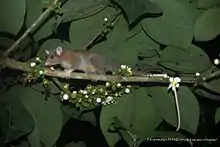
_male.jpg.webp)

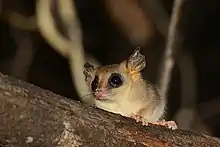
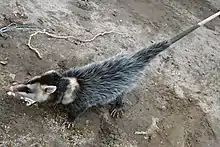



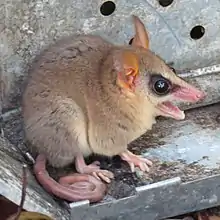
_-_Leonardo_Mer%C3%A7on.jpg.webp)

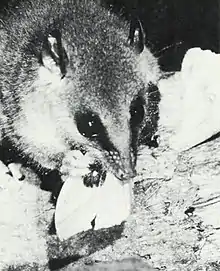
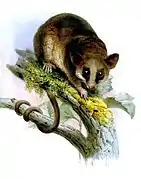


_(1888)_(20772821205).jpg.webp)



.jpg.webp)

_(8557387452).jpg.webp)
